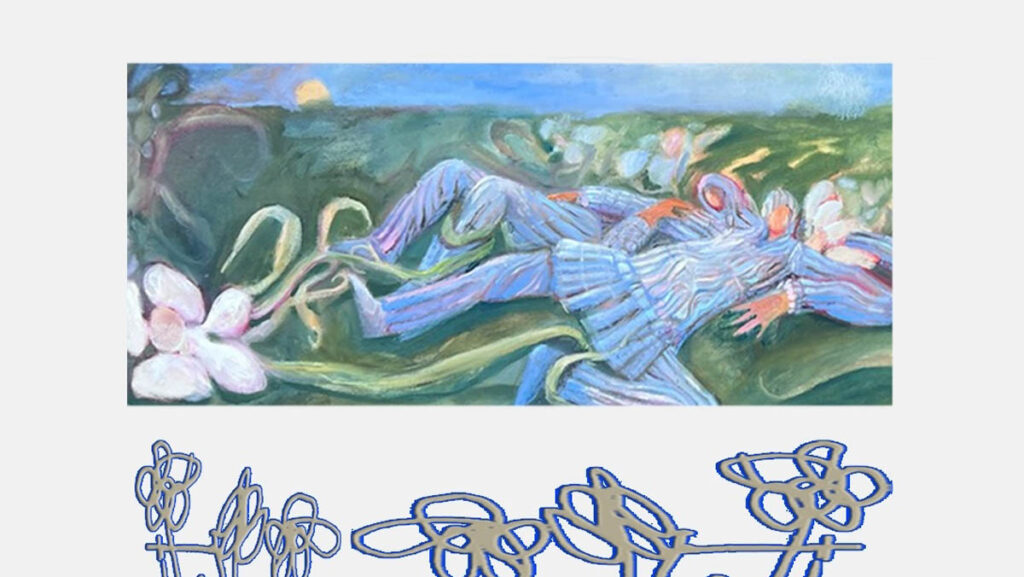
Inspired by the link between computers and Jacquard looms, her practice examines vulnerability, digital consumption, and personal narratives in an era of overwhelming information abundance. Bunney’s last exhibition, „Girls Peeing On Cars“, explored queer kinship and female friendship, meticulously rendering images of friends, anonymous women, and celebrity culture. Her work investigates how we construct and share our stories in the digital age, transforming ephemeral content into monumental artworks. Through examinations of trauma, parasocial relationships, and fan culture, she interrogates contemporary experiences of intimacy and recognition.
How do you approach your work’s selection and re-contextualisation of found imagery?
My thinking around found imagery is completely linked with the algorithm. Social media and the internet can sometimes make you feel like you’ve discovered this obscure image, but it’s being shown to hundreds of thousands of other people. Algorithms have their sense of time – certain people or objects are everywhere one month and gone the next. As an artist, I always wonder how I want to interact with this; do I want to make work that’s very of the moment, capturing something fleeting? Do I want to use an image that everyone has seen on their phones already? I don’t have a definitive rule about what images I use and how I use them, but I tend to gravitate towards imagery that’s a bit more on the periphery of the internet. I like imagery that captures the anonymous universality of online spaces.

Why did you choose pointillism as your central visual medium?
I used to be really into crochet, both artistically and as a hobby, and I always loved the visual imagery of a crochet lace pattern. After reading Sadie Plant’s ‚Zeros and Ones‘, I learnt that the Jacquard Loom (punch cards specifically) inspired Lord Babbage when he designed the hardware for the first computer. When I started drawing in a pointillism style, it was an interpretation of a punch card you might have used to code a computer years ago. Most people read the work as very techy, but if people know how to knit or crochet, they tend to read my paintings as a pattern for making textiles. I’ve made pointillism my central medium because of this dual reading; it’s the exact position I want to sit in.
What role does language play in your work?
I grew up watching a lot of YouTube, and I think that slightly clickbait, almost tongue-in-cheek way of naming things has become quite rooted in my brain. Naming is really a lens you’re giving the viewer to help them understand the work, but also can be a fun way to grab attention. Sometimes I write as a way to focus my thoughts, but I haven’t made a substantial body of writing for a while. It’s something I’m planning on getting back to soon.


In what ways do you think current representations of technology and care are insufficient, and how does your work attempt to fill this gap or provide a new perspective?
When I think about representations of technology and care as an artist, I’m thinking about the aesthetics of technology and how it relates to personal and emotional connection. I’m not a scholar on the subject, but I think the way we represent technology aesthetically in our art and culture tells us something about how we understand technology (and to an extent science) to function. We have seen science and technology as a map to an objective understanding of how the world works, but I don’t necessarily think that’s accurate or helpful. There are loads of ways science can be biased and can miss things out, and I’m not completely convinced that objective reality exists. It’s worth adding I’m a big fan of science, so this isn’t a critique so much as an observation. The aesthetics of technology, in art, end up feeling like we see technology as this inhuman, slick, higher-dimensional thing which exists out there in the aether waiting to be discovered by people. Which is a fun aesthetic I do enjoy, but doesn’t give us a full understanding of what technology is or how it’s made. Ultimately, I think technology is very human and is flawed and messy, the way everyone is. Technology is made in a community, and with community comes an understanding that we should care for each other.
My work takes me so long to make; it’s a real labour of love, and often I like to make work about or for the people I care for. These relationships that matter to me are often mediated through technology: WhatsApp, Instagram, and sharing TikTok videos. I think the inhuman way we portray technology can flatten the complexities of how technology affects the community, and I’m interested in doing something different.

What fascinates you about the intersection of science fiction, autofiction, and body horror?
They’re all genres I’ve just always been drawn to, especially science fiction. It’s something about the fantastical way the narrative conventions allow people to explore personal experiences or the way they link the body with larger things in the world. If I drew a Venn diagram of the three genres, I would say they overlap at the personal and the body, trying to take something personal and find places where personal experience overlaps with other people. I don’t necessarily find it comforting to think of my experiences as being unique; I want my experiences to be something other people can relate to. All these genres deal in metaphors that I often can relate to, and that links me with the author. Body horror, for example, acknowledges emotional or societal feelings by manifesting them as a physical, bodily transformation. Science fiction does this too, but often by manifesting new technologies and societies as a way of magnifying real-world anxieties about the future.
Do you have any rituals?
I feel a bit silly calling the things I do ritually ‚rituals‘, because they’re quite trivial. I love washing my face in the morning and evening. I love walking to the station in the morning. I drink a cup of coffee immediately when I wake up, and sometimes it’s the main thing I get out of bed for. I go for a run at least twice a week. I wish my rituals were a bit less centred on myself and more communal, but for now, my rituals are moments in the day for quiet introspection.

What role do intuition or desire play in your process?
I’m very interested in desire and specifically desire about embarrassment. Like when you fancy someone but you’re embarrassed about it. Sometimes I think of a work and feel embarrassed at the thought of making it, normally because I worry it seems frivolous or juvenile, or silly. Like doing a painting of a Sylvanian family. I earnestly enjoy them as objects, and I’m interested in why I feel that way, but I don’t want to take full ownership of that because I’m worried people will think I’m a stupid girl. And it’s like, Okay, so what? Why would people think that? Why does it bother me?
Intuition is more of a process than a material (desire, I think, is a material, not a process). I LOVE to overthink everything, and it doesn’t make for the best work because you get in your own way. Intuition is just trusting that I do know what I’m doing and why I’m doing it. I can reflect and intellectualise once something is done. I’d say it’s good to move between intuition and criticality.

What do you enjoy doing in your free time when you’re not working?
I’m an avid reader. I’m currently reading The Empusium: A Health Resort Horror Story by Olga Tokarczuk. I’m also very into hanging out with my friends in a fairly aimless way – wandering down a high street, going to a show, getting ice cream. Similar to what I might do when I was 16 and meeting people in town. I’m also in a bit of a Minecraft phase; I get really into the game every couple of years. I’ve got it in my head that it would be fun to design a texture pack for the game when I’m less busy, but to be honest, that would probably end up being a piece of artwork.
What projects are you currently working on, and when is your next exhibition scheduled?
I have a solo show coming up at Well Projects in Margate in May and a show at Eigan+Art Lab in Berlin in June. Then I’m hoping to do some more fun collaborative stuff with my friends.
Lily Bunney – www.lilybunney.com, www.instagram.com/lily_bunney_/





